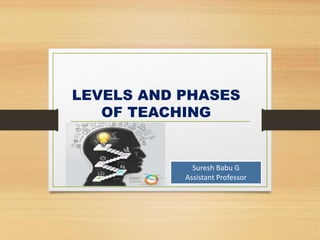
Levels and Phases of Teaching
- 1. LEVELS AND PHASES OF TEACHING Suresh Babu G Assistant Professor
- 2. PHAESE OF TEACHING Teaching is not an easy task. For performing this task a systematic planning is needed. Teaching is divided into three phases 1. Pre-active phase[Planning stage] 2. Interactive phase[Execution stage] 3. Post-active phase[Evaluation stage]
- 3. PHASES OF TEACHING 1.PRE –ACTIVE PHASE: Planning of teaching is carried over in this phase. This phase consist essentially of planning of a lesson. It includes the selection of content to be taught, organization of the content and selection of suitable teaching methods. 2. INTERACTIVE PHASE: It includes the execution of the plan where learning experiences are provided to students through suitable modes. Sizing up of the class and knowing the learner are included in this phase. 3.POST-ACTIVE PHASE: It involves teacher’s activities such as analyzing evaluation results to determine student’s learning. It concerns with evaluation activities. Major operations in this phase are perception, diagnosis, reaction etc
- 4. These three levels are Memory level: Thoughtless teaching Understanding level: Thoughtful teaching Reflective level: Upper thoughtful level LEVELS OF TEACHING
- 5. MEMORY LEVEL OF TEACHING The learner has to learn the material, retain the meaningful material, and reproduce that when asked for.
- 6. MEMORY LEVEL OF TEACHING Aims To get factual information To train memory faculty To retain the learning material in-memory storage To reproduce and recognize the learned information when required Objectives The objective of the memory level of teaching is just to impart information or knowledge to the learner. This knowledge or information is factual in nature, which is acquired through a mechanical process (i.e. memorization or rote learning).
- 7. Teaching Equipment and Evaluation System Teaching equipment - Teaching aids such as audio, visual and audio-visual aids. E.g. Models, Charts, Maps, Pictures, TV, Radio, Computers, etc. should be used to develop curiosity among the students. Evaluation System Oral and written tests are used to test the memory of the students. In evaluation; written test, short type test, recall type, recognition type, multiple choice, alternative type, and matching type test is employed. MEMORY LEVEL OF TEACHING
- 8. UNDERSTANDI NG LEVEL OF TEACHING Understanding implies to know the meanings of things and concepts, to grasp ideas, to interpret some relationship, to comprehend the facts, and to infer one thing from some other. At this level, the learners are required to comprehend factual information, to know the meaning of different concepts and their relationships, and to apply facts, concepts, and principles.
- 9. z Aims and Objectives Comprehension Objectives- Comprised of Translation, Interpretations and Extrapolation. Application Objective- Efficiency to apply to comprehend knowledge in various similar and different situations and settings. Understanding Objectives- It pertains to the understanding to instructional messages, by means of Interpretation, Exemplifying, Classifying, Summarizing, Inferring, Comparing and Explaining, etc. Application Objective- Application objectives include proper procedure for Executing, Implementing; the use of generalized rule or principle in practical life situations. Nature of Subject Matter Wide Larger in number Larger in quantity UNDERSTANDING LEVEL OF TEACHING
- 10. Methods used by Teacher: Lecture Method Lecture demonstration method Discussion method Inductive and Deductive method Exemplification and Explanation Teaching Equipment Different charts, models, flashcards, pictures, TV, and many more electronic devices are used as teaching equipment. Evaluation The teacher has to evaluate the ability to comprehend, grasp, synthesize, discriminate and generalize; and the insight to apply the generalized principles further so, the tests and tools should be properly planned and devised. Written tests should be conducted.
- 11. REFLECTIV E LEVEL OF TEACHING This level of teaching is the highest level of teaching-learning activity. It does not depend on memorization, understanding of concepts, and their application only; it demands the use of higher mental processes such as reasoning, thinking, analyzing concepts, imagination, ideas and thoughts; and other bodies of knowledge critically, finding out the facts.
- 12. Aims and Objectives • To develop insight into the learner to solve problems. • To develop rational and critical thinking in the students. • To develop the ability of independent thinking and decision making in the students. Nature of Subject matter The subject matter is mainly unstructured and open- ended. It is concerned with the problem rather than the subject. Methods used by Teachers Problem solving methods Investigating projects Heuristic method Experimental method Inquiry oriented method Analytical method Evaluation The evaluation system at the reflective level of teaching should test the higher order cognitive abilities like reasoning, creativity, original thinking, problem-solving, critical thinking, etc. REFLECTIVE LEVEL OF TEACHING
- 13. Thanks
